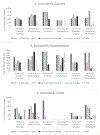Increasing Rates of Diagnosis, Substantial Co-Occurrence, and Variable Treatment Patterns of Eosinophilic Gastritis, Gastroenteritis, and Colitis Based on 10-Year Data Across a Multicenter Consortium
- PMID: 31008735
- PMCID: PMC6554065
- DOI: 10.14309/ajg.0000000000000228
Increasing Rates of Diagnosis, Substantial Co-Occurrence, and Variable Treatment Patterns of Eosinophilic Gastritis, Gastroenteritis, and Colitis Based on 10-Year Data Across a Multicenter Consortium
Abstract
Objectives: The literature related to eosinophilic gastritis (EG), gastroenteritis (EGE), and colitis (EC) is limited. We aimed to characterize rates of diagnosis, clinical features, and initial treatments for patients with EG, EGE, and EC.
Methods: In this retrospective study, data were collected from 6 centers in the Consortium of Eosinophilic Gastrointestinal Researchers from 2005 to 2016. We analyzed demographics, time trends in diagnosis, medical history, presenting symptoms, disease overlap, and initial treatment patterns/responses.
Results: Of 373 subjects (317 children and 56 adults), 38% had EG, 33% EGE, and 29% EC. Rates of diagnosis of all diseases increased over time. There was no male predominance, and the majority of subjects had atopy. Presenting symptoms were similar between diseases with nausea/vomiting and abdominal pain, the most common. One hundred fifty-four subjects (41%) had eosinophilic inflammation outside of their primary disease location with the esophagus the second most common gastrointestinal (GI) segment involved. Multisite inflammation was more common in children than in adults (68% vs 37%; P < 0.001). Initial treatment patterns varied highly between centers. One hundred-nine subjects (29%) had follow-up within 6 months, and the majority had clinical, endoscopic, and histologic improvements.
Conclusions: In this cohort, EG, EGE, and EC were diagnosed more frequently over time, and inflammation of GI segments outside the primary disease site co-occurrence of atopy was common with a lack of male predominance. Symptoms were similar between diseases, and initial treatment strategies were highly variable. Future investigation should assess the cause of the increased prevalence of eosinophilic GI disorders and prospectively assess outcomes to establish treatment algorithms.
Conflict of interest statement
Conflicts of Interest:
*The other authors have no conflicts of interest to declare
Figures



References
-
- Dellon ES, Gonsalves N, Hirano I, et al. ACG Clinical Guideline: Evidence Based Approach to the Diagnosis and Management of Esophageal Eosinophilia and Eosinophilic Esophagitis (EoE). Am J Gastroenterol 2013; 108: 679–92. - PubMed
-
- Walker MM, Potter M, Talley NJ. Eosinophilic gastroenteritis and other eosinophilic gut diseases distal to the oesophagus. Lancet Gastroenterol Hepatol 2018; 3:271–80. - PubMed
-
- Straumann A, Bauer M, Fischer B, Blaser K, Simon HU: Idiopathic eosinophilic esophagitis is associated with a T(H)2-type allergic inflammatory response. J Allergy Clin Immunol 2001; 108:954–961. - PubMed
Publication types
MeSH terms
Substances
Supplementary concepts
Grants and funding
LinkOut - more resources
Full Text Sources
Medical

